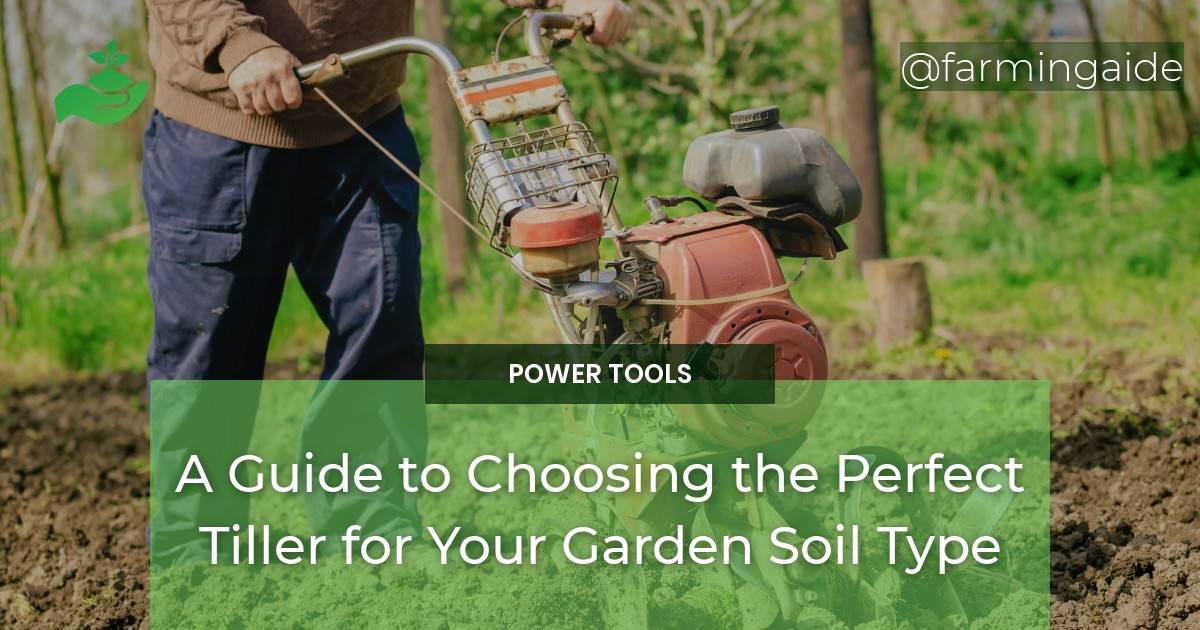If you are planning to start a garden, the first thing you need to do is to prepare the soil. Soil preparation is essential for creating a healthy and productive garden. One of the best tools for soil preparation is a garden tiller. A garden tiller is a powerful machine that helps loosen and break up compacted soil, allowing air, water, and nutrients to penetrate the roots of your plants. There are so many types of tillers available in the market, it is hard to choose the perfect tiller for your garden soil type. The right tiller can make all the difference in how productive your garden is, so it’s important to know how to choose the right one.
In this article, we’ll discuss how to choose the perfect tiller for your garden soil type. We’ll go over the different types of tillers, and what to look for when making your decision. We’ll also discuss how to use your tiller correctly, as well as tips for maintaining your tiller to ensure it lasts for many gardening seasons to come.
Table of Contents
Understanding Your Garden Soil Type
Before choosing a tiller, you need to identify your garden soil type. The three major types of garden soil are sandy soil, clay soil, and loamy soil.
Sandy Soil
Sandy soil is made up of larger particles that don’t hold water or nutrients well. Sandy soil tends to dry out quickly and requires frequent watering. The benefit of sandy soil is that it is easy to till and doesn’t require much effort.
Clay Soil
Clay soil is made up of smaller particles that hold water and nutrients well but can be difficult to till because it is heavy and compacted. Clay soil tends to hold onto moisture, making it slow to warm up in the spring.
Loamy Soil
Loamy soil is a combination of sand, silt, and clay. It is considered the ideal soil type for gardening because it has good drainage, holds water and nutrients well, and is easy to work with.
Types of Tillers
There are three types of garden tillers: front-tine tillers, rear-tine tillers, and mini-tillers.
Front-Tine Tillers
Front-tine tillers are ideal for small to medium-sized gardens. They are lightweight and easy to maneuver, making them perfect for novice gardeners. Front-tine tillers are less expensive than other types of tillers and are perfect for tilling sandy or loamy soil.
Rear-Tine Tillers
Rear-tine tillers are more powerful and are ideal for larger gardens or tough clay soils. They are more expensive than front-tine tillers and require more effort to operate. Rear-tine tillers are perfect for tilling clay soil and breaking up hardpan.
Mini-Tillers
Mini-tillers are perfect for small gardens and tight spaces. They are lightweight and easy to maneuver, making them ideal for novice gardeners. Mini-tillers are less powerful than other types of tillers and are perfect for tilling loose soil or preparing garden beds.
Factors to Consider When Choosing a Tiller
There are several factors to consider when choosing a tiller for your garden, including garden size, tilling depth and width, power source, tines, and budget.
Garden Size
Consider the size of your garden when choosing a tiller. If you have a small garden, a front tine or mini-tiller would be perfect. If you have a large garden, a rear-tine tiller would be more suitable.
Tilling Depth and Width
Consider the depth and width of tilling you require. If you need to till deep into the soil, you should choose a rear-tine tiller. If you need to till a wide area, a front-tine tiller would be more suitable.
Power Source
Consider the power source of your tiller. Gas-powered tillers are more powerful and can handle tougher soil types, but they require more maintenance. Electric tillers are less powerful but are perfect for small gardens and are easier to maintain.
Tines
Consider the type of tines used by the tiller. Rear-tine tillers have counter-rotating tines that are ideal for breaking up tough soil. Front-tine tillers have forward-rotating tines that are perfect for tilling loose soil.
Budget
Consider your budget when choosing a tiller. Front-tine tillers are less expensive than rear-tine tillers, making them ideal for novice gardeners on a budget.
Recommended Tiller for Your Garden Soil Type
Sandy Soil
For sandy soil, we recommend a front-tine or rear-tine tiller. These tillers are perfect for tilling loose soil and preparing garden beds.
Clay Soil
For clay soil, we recommend a rear-tine tiller. These tillers are powerful enough to break up tough soil and are perfect for preparing garden beds.
Loamy Soil
For loamy soil, we recommend a front-tine or rear-tine tiller. These tillers are perfect for preparing garden beds and tilling loose soil. Mini-tillers are also suitable for small gardens.
Maintenance and Safety Tips
Maintenance Tips
Proper maintenance of your tiller is essential for the longevity of your machine. Keep your tiller clean and free of debris. Change the oil regularly and keep the air filter clean. Check the tines and belts for wear and tear and replace them as needed.
Safety Tips
Always wear protective gear when operating a tiller, including gloves, eye protection, and sturdy boots. Keep children and pets at a safe distance when operating a tiller. Be aware of your surroundings and avoid rocks, roots, and other obstacles that could damage your tiller.
In conclusion, choosing the perfect tiller for your garden soil type is essential for creating a healthy and productive garden. Consider your garden size, tilling depth and width, power source, tines, and budget when choosing a tiller. For sandy soil, we recommend a front-tine or rear-tine tiller. For clay soil, we recommend a rear-tine tiller. For loamy soil, we recommend a front-tine or rear-tine tiller or a mini-tiller for small gardens. Proper maintenance and safety precautions are essential for the longevity of your tiller and your safety. With the right tiller, you can create a beautiful and productive garden that will provide you with fresh, healthy produce all season long.


